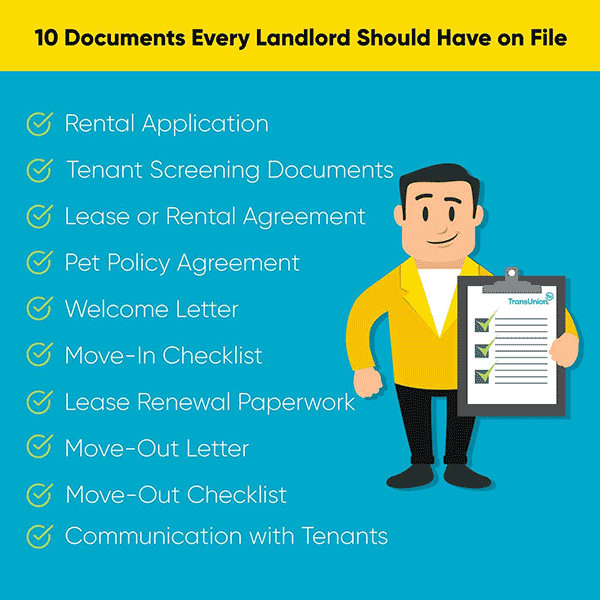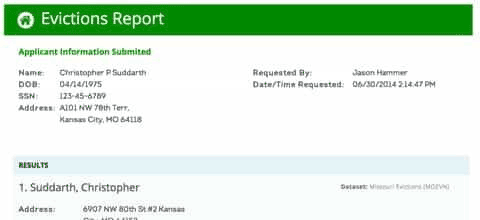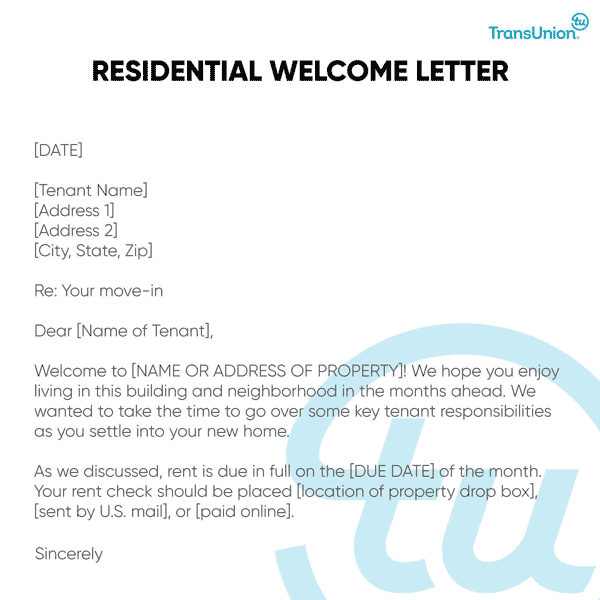10 Rental Documents Every Landlord Should Keep on File

Landlords have plenty on their plate, especially considering being a landlord most likely isn’t their full-time job. Between finding great tenants, avoiding evictions, and making sure leaky faucets get fixed in a timely fashion, it can sometimes feel like there’s a never-ending list of tasks to complete.
In addition to day-to-day operations, a pile of paperwork surrounds nearly every to-do: security deposits, rent payments, receipts for maintenance repair—the list goes on and on. Whether you want to itemize your tax return or ensure compliance with the law, chances are that you as a landlord will need a form to document the transaction.
Keeping your rental documents organized is key to promoting a great landlord-tenant relationship and can help ensure your rental business runs smoothly. You may feel overwhelmed by the stack of rental paperwork a landlord handles on a regular basis, but you can consider this comprehensive list to keep track of what you have (and what you’re missing) on file.
Record-keeping is important at every point of being a landlord, but before you worry about alphabetizing your filing cabinet, make sure you start by renting to great tenants.
Screening potential tenants is key to finding out if someone is who they say they are. We suggest TransUnion SmartMove® because it’s designed to be used by independent landlords, and you can get credit reports, criminal background checks, and eviction history insights in just minutes.
Why Should Landlords Keep Records?
Staying organized and keeping the right records on file can help landlords:
- Better protect against legal issues
- Deal with tax responsibilities
- Promote transparency between landlord and
Protect against litigation
Even if your tenant screening process goes smoothly, you may find yourself in a dispute with a tenant who you thought was a great fit. According to Realtor.com, these (linked) are some of the most common reasons tenants sue their landlord. Here is some additional commentary/general principles:
- Setting policies that discriminate against families: Remember, it is generally illegal to discriminate against renters based upon familial status. You typically cannot deny an applicant based on the fact that they have a
- Asking the wrong screening questions: Stick to objective, unbiased questions regarding income level and rental history. Avoid including any questions on the rental application or screening process that could be perceived as subjective or discriminatory (age, sexual orientation, etc.).
- Using generic or outdated lease agreements: If you fail to update your lease regularly, it might contain vestiges of outdated provisions that have since been updated or outlawed. A generic lease used as an umbrella agreement for each tenant may not be thorough enough to hold up in court and may be manipulated or misinterpreted to your tenant’s benefit.
- Charging excessive late fees: Per NOLO, there are laws that govern the limit on late rent fees. It varies by state. Make sure your lease states when a fee will be assessed (typically, after three days of non-payment) and exactly how much your tenant will be expected to pay.
- Violating a tenant’s right to privacy: When you lease your property, you generally can’t enter the unit as you please. You may have a duty to provide advanced notice prior to coming onto the property, unless in the event of an emergency that requires an immediate entry. These reasons should be explicitly stated in your rental document. Housing laws vary by state, so do your research regarding your tenant’s right to privacy according to where you live, and consult your legal counsel.
- Wrongly using or withholding a security deposit: If a tenant moves out, then it’s wise to take pictures of any damage you notice beyond normal wear and tear. We’ve seen a generally small population of landlords reporting that they returned a security deposit in full, so more likely than not, you’ll need to keep at least a portion of the deposit to cover repair costs.
When that happens, it may be your duty to provide your former tenant with an itemized receipt of expenses—including the billable labor and raw materials used—and to return the remaining amount within a specified time frame, or risk facing a lawsuit.
- Ignoring dangerous conditions in or around the rental property: Tenants generally have the right to a livable place and, you may have a responsibility to provide basic necessities such as heat, water, sturdy floors, structurally intact walls, strong roof, absence of significant danger (from lead, asbestos, and mold). Do check laws applicable to you and consult your legal counsel. Delineate which types of property maintenance you are accountable for, as well as which repairs fall upon the tenant, in your rental document.
Landlord forms and rental documents can also provide evidence if you ever need to take action against one of your renters. Take a look at some of the most common examples below.
- Unpaid rent: 84% of landlords agree that a renter’s failure to pay rent is their top concern. If you’re struggling with a tenant who has not paid, you may have to first send a landlord form notifying the tenant to pay rent or quit the lease. If that does not work, you may be able to file an eviction and sue for the rent owed. Check with your legal counsel.
- Damage to the property: Your rental document states that you have the right to deduct expenses from the tenant’s security deposit due to repairing property damage. If the deposit is not enough to cover all costs, then you should take detailed rental documents and receipts to (what may be) small claims court in hopes of having the rest returned to you. Consult your legal counsel.
- Recover money due to an early move-out: Tenant turnover and rental vacancies can take a serious hit on your income—especially if a tenant moves out abruptly and violates their lease, leaving you with a vacancy. You may be able to recover rent; check with your legal counsel.
Streamline your tax filing responsibilities
When tax season comes around, proper documentation will ensure your filing process is streamlined – no surprises in store. Landlords have certain tax responsibilities, amongst others; if you own real estate and run your own rental business, you likely have a federal tax responsibility to report all rental income on your annual taxes. In addition, landlords may qualify for money-saving tax deductions – but in order to claim these deductions, it’s crucial that you have accurate records. Check with your tax/finance professional.
With organized, detailed rental documents, you can find receipts, track deductible expenses, and accurately prepare your tax returns.
Promote transparency
Creating and maintaining a respectful landlord-tenant relationship is a priority. Providing your renters with detailed documentation throughout the duration of their tenancy can help you facilitate a mutually beneficial relationship.
Documentation can be used to welcome tenants, to explain your expectations for their tenancy upfront, and to streamline communication. By promoting transparency, landlords can start each tenant relationship off on the right foot.
As you can see, storing and organizing landlord documents can help you protect against litigation, streamline your tax filing processes, and improve your relationship with your tenant.
So, without further ado, let’s break down exactly which landlord documents that you should have on-hand.
What Forms and Documents Should a Landlord Keep on File?
While not exhaustive, this comprehensive list of important landlord forms and documents is a great starting point. Always check laws applicable to you, and you should consult legal counsel.

1. RENTAL APPLICATION
Your rental application is designed to inform you of a prospective tenant’s qualifications and is often used as a first step to qualify or deny an applicant. Requiring a rental application can reduce the risk of placing the wrong tenant in your unit.
The typical rental application covers:
- Contact information
- References
- Current and previous residence information
- Employment history
- Proof of income
- Authorization to pull a credit report and criminal record (SmartMove tenant screening prompts your applicant to authorize the pull themselves, so you don’t have to worry about this step with SmartMove)
Keep all applications, including rejected applicants. The length of time you need to keep the documents depends on federal and state laws.
How to make a rental application:
- Refer to your local real estate association
- Create your own following trusted guidance
- Find an existing rental application online
*No reliance upon or endorsement of a particular online application is made, implied, or represented. Terms and conditions may apply for use of any form of a lease agreement. Always review applicable laws, and consider checking with your legal counsel.
2. TENANT SCREENING DOCUMENTS
After collecting rental applications, you’ll need to screen your prospective tenants. According to SmartMove data, more than 95% of landlords believe tenant screening is beneficial and helps them get a higher-quality tenant into their rental unit. Don’t settle on the first rental applicant you receive; insights from TransUnion pulled in 2017, show that landlords screen an average of two applicants per rental property.
SOME GENERAL PRINCIPLES TO CONSIDER IN CREATING A TENANT SCREENING POLICY:
- Create rental criteria, document them, and apply them universally across all applicants to remain objective.
- Keep a list of pre-screening questions and ask every applicant the same ones.
- Call tenant’s listed landlord references, sourced from their rental application, and be prepared with a list of reference questions.
- Tenant screening reports should also be included within your rental documentation, but traditional background checks require mountains of paperwork and are a hassle to keep track of, organize, and store. By using SmartMove to run a rental credit check online, you can easily keep track of all important information stored in one convenient place (the Internet).

3. LEASE OR RENTAL AGREEMENT DOCUMENTS
A document that a tenant can occupy a property for a specified period of time. It also defines the rights and responsibilities of both landlord and tenant. As noted earlier, the lease can be your ally when it comes to future litigation or tenant disputes.
Rental terms may vary, but should generally include the following:
- Your role, duty, and rights as a landlord
- Tenant’s responsibilities and rights
- Dates and terms of the lease
- Protection of property and tenant accountability
- Payment terms, including when rent is due and how to pay it
- Outline of the eviction process
According to a SmartMove user survey, the top two concerns of landlords are renter payment problems and a tenant’s eviction history. Writing a detailed lease is essential, as it acts as a contract if you ever need to evict a tenant. There are many lease agreements available for use online (this is another reminder that no reliance upon or endorsement of a particular online resource is made, implied, or represented. Terms and conditions may apply for use of any form of the lease agreement. Always review applicable laws, and consider checking with your legal counsel as to any particular lease agreement).
Note: A landlord’s legal obligations dont always end when the lease agreement is fulfilled. The IRS could audit a landlord who makes rental income years after the termination of a lease agreement. If legal disputes arise later on, then lease documentation might become a critical element for winning your case. For that reason, store the lease on file even after the tenant moves out.
4. PET POLICY AGREEMENT
If you decide to make your rental property pet-friendly, then it’s wise to have a documented pet policy on file. Tenants should be required to sign this landlord document, which may include the need for an additional pet deposit, pet rent, or expected pet owner responsibilities.
5. WELCOME LETTER
A welcome letter is a friendly greeting for your tenant that is also rich with information. It may explain details such as:
- How to set up utilities
- How to get renter’s insurance
- How to pick up keys
- How to use laundry unit/room
It may be simple, but this rental document can help ease the transition for your tenant and will go a long way for your landlord-tenant relationship. Below is an excerpt of a sample welcome letter; and here is another gentle reminder to review laws applicable to you, and consider checking with your legal counsel to ensure your welcome letter is compliant.

Pro-tip: Consolidate your landlord forms by combining the tenant welcome letter with a move-in checklist.
6. MOVE-IN CHECKLISTS
A move-in checklist helps you keep track of the condition of your property and holds your tenants accountable for any damage that occurs while they live there. Without the checklist, it’ll be your word against theirs after move-out.
This rental document also provides peace of mind for tenants, as it assures you won’t charge for damages for which they weren’t responsible. Go over the checklist with your tenants at move-in, and again at move-out. This will help determine if the tenant has damaged your property beyond normal wear and tear.
7. LEASE RENEWAL PAPERWORK
Lease renewals can help landlords save time and money and offer many benefits to a seamless renewal process, including:
- Eliminating the cost of finding new tenants
- Reducing the risk of vacancy
- Reducing the risk of an incompatible tenant moving in
- Keeping a tenant already familiar with lease terms
Be proactive with your renewals and ask your tenant 90 days in advance whether they wish to renew the lease. There are many sample renewal applications available online that you can use as a starting point.
8. MOVE-OUT LETTER
If your tenant plans to vacate the property, you’ll want to send a move-out letter about a month before the lease ends. This landlord document is beneficial because it sets expectations for tenants, such as their responsibilities before vacating the property and the next steps for returning the security deposit.
A smooth transition could help reduce vacancy and ease the stress of turnover. On average, one month of vacancy costs a landlord 1,750, but wasted time can be even more of a loss. There are many tasks you’ll need to complete between scheduling showings and screening tenants, so keeping this rental document on file can assist in streamlining the transition.
Create a move out letter that explains these items (not an exhaustive list):
- Cleaning requirements and expectations
- Date and extent of your final inspection
- Security deposit deductions
- Important reminders
- Request for a forwarding address
9. MOVE-OUT CHECKLIST
A tenant move-out checklist can help spell out a tenant’s responsibility when vacating your rental property. Consider attaching this checklist to the lease agreement because if your tenant understands the expectations upon move-in, they can better accomplish each requirement.
This is mutually beneficial. For landlords, the rental space is left in better condition. For tenants, they have a better chance of having their security deposit returned.
10. COMMUNICATION WITH TENANTS
Within your rental documents file, keep track of correspondence with tenants from the moment they apply until the moment they move out. This may include:
- Email chains
- Texts messages
- Dated notes from telephone/in-person conversations
Should you ever need to contest a conversation, having these detailed records on file could help protect you.
How Landlords Should Store Important Documents
One of the most important tips for new landlords is to keep digital records of everything. Scan all your rental documents and save the files on cloud storage so that your forms stay organized. It’s wise to keep hard copies as well in something like a fire-retardant safe deposit box.
One Form to Rule Them All
It’s obvious that keeping important documents on file can protect your rental business, but the most important step in preserving your property and revenue is by renting to great tenants from the start.
TransUnion SmartMove provides near-instant, online tenant screening reports that give landlords crucial background data regarding their prospective renters. By screening credit checks, criminal backgrounds, and eviction histories, you’re empowered to make greater tenant selections.
And now, with proprietary features like ResidentScore and Income Insights, you’ll be privy to trusted TransUnion data that help you better predict your risks of a renter not paying or getting evicted.



